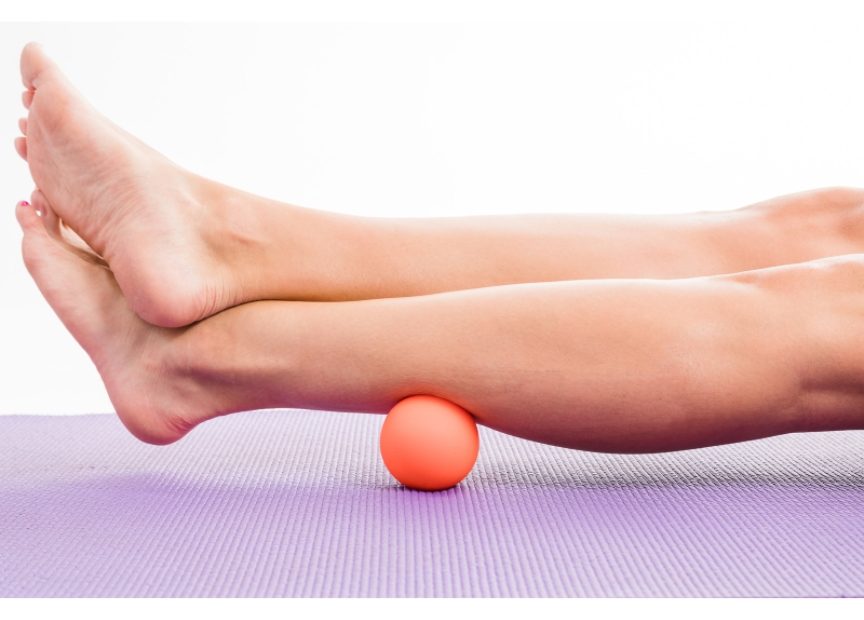More and more sports medicine practitioners and athletes use MFR (Myofascial release) to keep their bodies at optimal performance and to improve their recovery after exertion or injury. Sports medicine research is only now starting to show how important the health of your fascia actually is. A lot of injuries, previously thought to have been located in the muscle, are actually in the fascia instead.
Designed to release or relax the muscles, and improve blood and lymphatic circulation, using pressure to massage the tissues, encourages hydration and smooth gliding between layers as well as collagen production. A deep pressure massage is just the thing!

Self-Mfr with balls or foam rollers can be like your secret DIY massage kit. Unlike a deep tissue sports massage though, MFR balls or foam rollers can be very inexpensive and aren’t even necessary if you use tennis balls or a rolled-up yoga mat.
It is very accessible as it can be done standing, seated or laying down. You are the one applying the pressure and get immediate feedback from your body, which truly puts you in charge.
With just a few simple techniques, you are empowered to tackle muscle soreness and more at home or anywhere.
So what the F is fascia anyways?

Fascia is connective tissue like tendons or ligaments which attaches, connects, surrounds and supports all of our muscles and organs. Imagine a thin layer surrounding everything throughout your body from head to toe. Because it is an interconnected layer that communicates, it is possible to “do” MFR in one area or on one part of your body, to benefit another. You may even feel the effects elsewhere or hours to a day later! Similar to the principle of reflexology though, this means you can benefit your low back for example, by concentrating MFR on the glutes.
Why do you need MFR?
Prolonged inactivity like a more sedentary lifestyle or repetitive stress in your work or workout can all negatively affect the health of your fascia. Maybe you work from home since COVID-19 or you love vinyasa yoga but your shoulder has had enough of chaturangas.
Reduced hydration and circulation in the fascia can cause compromised mobility and flexibility in some areas, as well as knots or tender trigger points. This hardening of the tissues or “velcro-ing”, can also be caused by injury or trauma. Stress can cause our muscles to harden on a daily basis.
You can help to smooth, relax and rejuvenate these tissue with myofascial release.
Self-MFR can be the secret ingredient to regain mobility and flexibility in your yoga practice if done as a warm-up. It can also reduce soreness and recovery time if you are coming back to yoga after an injury.
Hydration, hydration, hydration
We all know that our bodies are mostly made of water and how important it is to hydrate. And just like that, the health of your fascia greatly relies on hydration.
I understand it a little like a ketchup bottle that’s been standing for a while. The ketchup will be pretty thick and doesn’t want to come out. If you give it a good shake though, it becomes more liquid and you can finally pour it all over your fries, or chips where I come from.
Movement helps the liquid components of your fascia to be able to flow. Yoga and other forms of exercise keep things moving throughout your entire body, whereas self-MFR allows you to target specific areas, according to your needs and preferences.
Tap in to your nervous system
I love yoga as a way to connect my racing mind to the present moment and self-MFR allows me to tap further into the “feeling” or yin-like part of my practice. It can be a valuable self-care tool as you explore what feels beneficial and feel empowered to use MFR where and when you need it. You can calm and ground yourself before practice or find your way to a more relaxed meditation.
Rolling or massaging is not meant to be done on bone or on any painful area and you should always consult your physician before you add a new component to your workout or health routine. However once you have felt the difference you can make to your achy legs and feet or a terribly sore muscle in a short amount of time, you will want to incorporate this into your warm-up, cool down and any other time you can!
